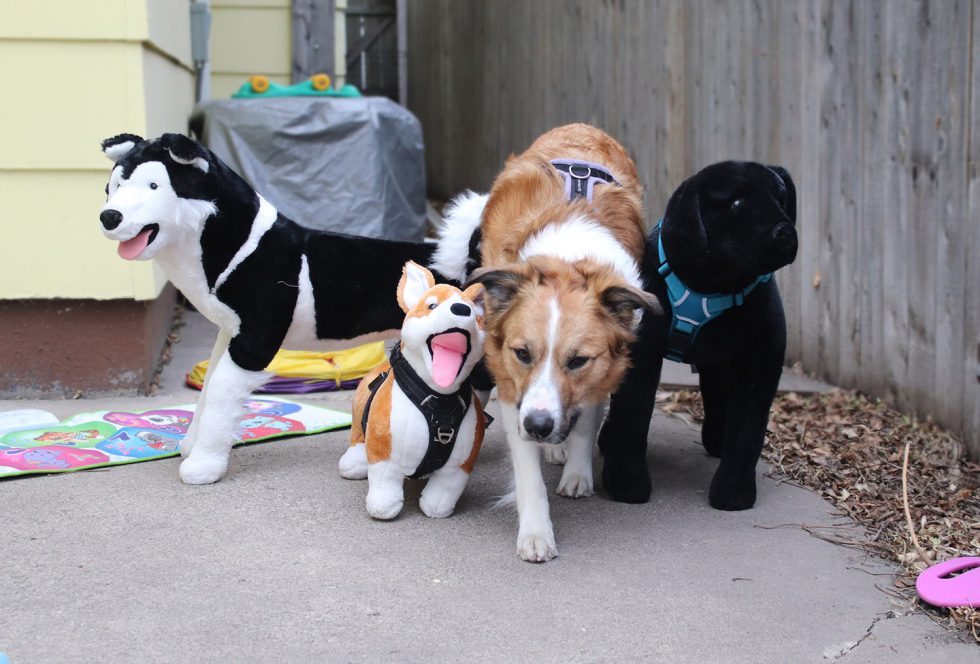In my training practice I frequently use stuffed dogs in socialization, and as behavior modification aids for dogs with reactive or aggressive behavior. Shelters use realistic stuffed dogs and sometimes life-sized dolls resembling human children in behavior evaluation. However, it’s been asserted that using a realistic stuffed dog (a “fugazi”) provides developmental benefits to young puppies as well as social and mental benefits to adult dogs, thanks to dogs’ presumed ability to pretend these toys are real.
So what does the research say?
In the case of shelters, there may be a lack of resilient helper dogs, plus safety concerns that come with unknown histories, to evaluate dog-dog behavior. So it’s been debated whether reactions to fugazi can be relied on as evidence of how they respond to real dogs, and note: with enough accuracy to influence a euthanasia decision. This brings us to the only research on the topic to date. We have an unpublished study by Dr Pamela Reid on adult fight bust dogs that did show reasonable consistency in behavioral reactions between real vs. stuffed dog greetings, one by the same ASPCA team on fight bust puppies, which showed no consistency combined with a bunch of the usual predatory behavior dogs exhibit towards the plushies, plus two studies that found some consistency, but which varied with the dog’s reaction (Shabelansky et al., 2015 and Barnard et al., 2019).
Why social and developmental benefits are unlikely.
When considering potential social benefits, the first thing to note is that dogs don’t think fugazi are real once they get up close, which isn’t surprising. Some dogs are initially conflicted, confused or optimistic that the toy is real, but the vast majority quickly think something is off. This has been my experience, that of my peers and is noted in the studies referred to above. Additionally, a stuffed dog presents rigid, unmoving body language. Contrary to popular claims on TV about calm submissive states, a stiff, unmoving dog is usually upset. So the fugazi resembles a freeze in a dog who is warning they may attack. It’s common in my experience for fugazi to evoke fearful reactions close up, even in dogs who are normally dog-friendly. I use fugazi in puppy socialization, not to provide social benefit but as an opportunity to countercondition that initial concern they have for these weird fabric statues, as real statues and taxidermy are common in my city. Once puppies are fully comfortable with the stuffed dog, they either treat it like a boring object or play with it as they would any other plush fabric toy.
So for now we can dismiss the idea of social benefits from fugazi: dogs really do not believe toys are real. But what about games of pretend having developmental benefits for puppies or undersocialized dogs?
Humans have what’s called “theory of mind” along with incredible abstract, conceptual cognitive abilities starting at a pretty young age. This lends itself to social development through watching others, watching representations of others or pretending themselves. I’m unconvinced dogs have this capacity. Puppies develop social skills and bite inhibition largely in response to the reactions of other puppies. Bite too hard and the other pup may yelp, leave or even lash out at the offender. Puppies need to experiment with their behavior to see what works and what doesn’t, but they can’t get feedback from a stuffed dog and I have yet to see evidence they can think up specific “what-if” scenarios the way humans do. So for now we can dismiss the idea of social benefits from fugazi: dogs really do not believe toys are real.
Potential benefits: they might not be what you think.
Now, that’s not to say that some benefits of fugazi play put forward by some trainers aren’t real. For overzealous young dogs it’s enrichment to let them go to town on a stuffed toy. Meeting dogs’ needs and providing them a chance to relieve frustration is likely to improve their behavior towards real dogs. Is this because the subject of play is specifically a dog shaped stuffie? I find this doubtful. How do we know a large pillow with no animal features wouldn’t serve the same purpose? This has not been tested.
There’s also likely benefit to young puppies from stuff like a “Snuggle Puppy,” which is a stuffed dog with fur-like fabric, a heat pack and a device that creates a simulated heartbeat. It can help small puppies transition to a new home without their mom and littermates, but not because they think or pretend it’s real. More likely, the Snuggle Puppy is simulating a comforting, familiar tactile environment.
So why does all this matter?
It’s not uncommon for dog trainers to talk about new ideas and training possibilities amongst ourselves. I frequently engage in open-minded, hypothetical discussions and even try out new approaches with my own dogs. There’s a reason, however, that we have a gold standard for scientific research, not to mention entire books detailing logical fallacies. The Academy for Dog Trainers teaches strict adherence to evidence-based training methods and procedures that we know will help dogs when working with clients. As experts for hire, when we present what we think or want to be true as fact, despite having no evidence, we risk misleading owners about what they should put their limited time, money and effort into. In the case of dogs playing make believe with fugazi, we risk distracting puppy owners from the urgency of socialization opportunities with real puppies. We risk distracting fearful dog owners from developing body language fluency and mechanical training skills. So let’s keep discussing, let’s keep researching, but let’s hold off on making definitive assertions until we can be certain that, even with the best of intentions, we’re not trying to sell dog training snake oil.
This post was inspired by a Psychology Today article The Magic of Make-Believe for Our Dogs, published January 10, 2022.
References
Shabelansky, A., Dowling-Guyer, S., Quist, H., D’Arpino, SS., McCobb, E. (2015). Consistency of shelter dogs’ behavior toward a fake versus real stimulus dog during a behavior evaluation. Applied Animal Behavior Science, 163, 158–166.
Barnard, S., Kennedy, D., Watson, R., Valsecchi, P., Arnott, G. (2019). Revisiting a Previously Validated Temperament Test in Shelter Dogs, Including an Examination of the Use of Fake Model Dogs to Assess Conspecific Sociability. Animals, 9(10), 835.
Collins, K., Reid P. (2009) Assessing Conspecific Aggression in Fighting Dogs Proceedings of the AVSAB/ACVB Meeting
Collins, K., Reid P., Martinez L. (2009) Bred To Fight: Evaluating Play In Pit Bull Puppies From Fighting Lines Proceedings of the AVSAB/ACVB Meeting











